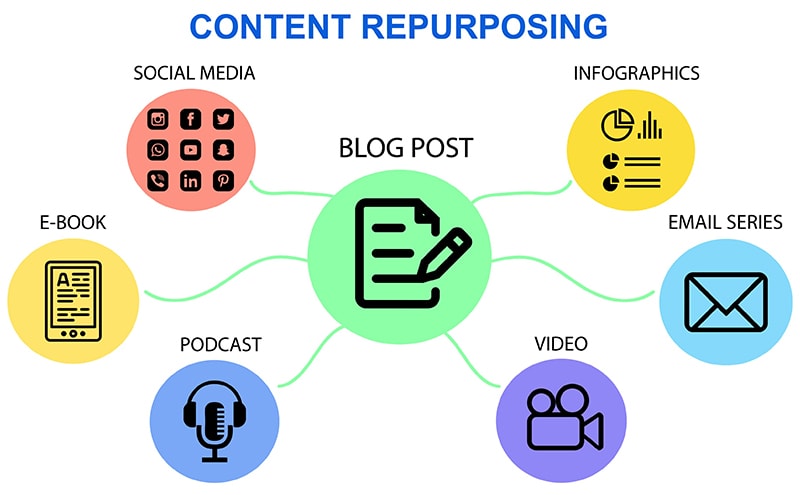Success or failure of content strategy is extremely subjective to a variety of factors: lots of different goals, long-term effects, goals changing over time, complex data analysis, content attributions, and influences from the outside.
Given that, quite a few business owners and managers are disappointed with its invisible results, even though heavy publishing of 12 to 20 blogs a month, aggressive social media promotions, and email drip campaigns with segmentation have been exercised.
This could be as a result of dissatisfaction arising from flaws in the strategy of content which limit it from achieving the results for which it was implemented. Since there are probably many defects in a content strategy, it’s crucial to point out some of the most critical ones that are commonly leading to its failure.

Deviating from Your Target Audience
One of the most frequent but important reasons for the failure of a content strategy is moving away from the target audience.
We have encountered this very much when considering the amount of experience working with numerous IT companies. Their target audiences normally sound well-carved around Tech Business Owners, Non-tech Business Owners, CTOs or Project Managers, and Developers.
A common mistake, however, is when IT companies follow the line of trends competitors set, regardless of whether their sales team wants that or not.
They may adopt flutter development if competitors do, switch from custom end-to-end development to staff augmentation if competitors do it, or start creating technical blogs if competitors have already written several.
This act of following industry trends is understandable but it leads to an unconscious feeling of bewilderment among target audiences far too often.
It is easy to stray from the target audience because even the slightest change in business goals or strategies, poor or outdated audience research, organic growth of a customer base, misinterpreted data, change in industry dynamics, and many more reasons may facilitate this.
However, this gives content strategy a problem in that it leads to misaligned content that is inefficient and ineffective in connecting to the right audience. Reasons for this problem may include:
- Irrelevant content creation for different segments of audiences.
- Waste of time and effort apart from a budget resource.
- Inconsistent branding is consequent to such a tragedy.
- Attracting the wrong leads, or low conversion rates may be another detrimental scenario.
- Lack of effectiveness measurement accuracy.
- Consequent to that, the ROI remains unjustified.
A well-framed content strategy needs to be sharply focused on the needs of its audience, creating a strong bond with them and driving much-desired results for the business.
Failure to Understand the ‘Why’ of Creating Content
Identifying content topics is a strategic effort that requires an understanding of why the content is being created. Unless one understands the purpose, defining the success metrics will be quite difficult.
Undefined success metrics lead to orphaned content, cannibalized, or unhelpful content. And investment without returns in such content is cyclic.
Avoid relying only on the following as the primary purpose for your content:
- Following competitors’ trends.
- Pursuing higher rankings.
- Expecting all blogs to generate sales-qualified leads (SQLs).
- Believing certain topics would be helpful to your audience.
- Catering to the preferences of your product team.
- Addressing the desires of your sales team to promote specific features in a particular geography.
Instead, it’s essential to measure what your audience actually needs, and what they’re looking for when purchasing your products or services. The purpose of your content should be manifold in two ways:
- Satisfying the expectation of the readers from the content.
- Attaining desirable results once the user reads content and satisfaction is derived.
Being clear about these aspects becomes very crucial to avoid the failure of your content strategy.
You may also like: Effective SEO Strategy For The Age of AI-Powered Search
Neglecting KPIs and Timelines for Each Piece of Content
Knowing why content is being created is one thing, but failing to know how to measure the fulfillment of that purpose can be the other reason for failure.
Most content calendars include basic fields like content themes, types, intended audience, responsible team members, dates of publishing, keyword info, word count, whether graphics are required, and references. What each post is actually trying to accomplish is rarely achieved.
We never included concrete numbers or metrics on what our content was intended to reach in our SEO-focused content strategy previously.
Content KPIs differ depending on the purpose of the content and total content strategy, but once more, you’d want to drive home outcomes that ensure effectiveness in your content. It is not good enough to have defined KPIs; there also needs to be timescales set around when these are achieved.
Here’s what can happen with your content strategy if you don’t set up content KPIs and their respective timelines:
- Ineffective use of resources: Where KPIs have not been set, enormous resources will be spent on creating YouTube videos which ask the question as to whether viewed videos add to brand awareness, customer engagement, or an increase in sales.
- Aimless creation: Writing and publishing a blog post becomes meaningless without predefined KPIs and timelines; hence, topics that are general in the industry get picked without having specific business goals in mind.
- Irregular performance: Creating different types of blogs without any pre-defined KPIs and timelines leads to irregularities in writing. Not only will it be hard to tell which type of content performs better, but it also complicates the process for improvement and comparison. For example, due to the regular publication of an email newsletter, there will be no specified KPIs and/or timelines for knowing whether alteration in open rates or click-through rates calls for improvement or is inside the bounds of normal variation.
- Missed opportunity: Not defining KPIs and timelines in the e-commerce or D2C segment for holiday-themed content implies missing those peak seasons for better visibility or sales.
- Difficulty adapting: In case a content strategy for software review sites doesn’t provide any timeline for renewals during major software releases, then that content has lost its rankings and website traffic. If there is no definition of KPIs and timelines, one will barely recognize when changes are needed.
- Not learning from or improving upon: Without pre-defined KPIs and timelines, one can’t say which blog serves what purpose; all this makes data-driven insights impossible for substantial informed decision-making and refinement of strategy with time.
- Unclear ROI: Absence of KPIs and timescales makes the return on investment calculability difficult for content efforts; hence, leaving doubts about whether resources put into work actually yield intended outputs.
- Demotivation of teams: All content creators and marketers will feel a lack of motivation to continue to follow the content strategy with enthusiasm, if they do not have specific objectives or results linked to their work.
Through the above disadvantages, the need is felt for a structured approach so that the content efforts are meaningful, measurable, and adaptive to ensure better achievement of results through a more effective content strategy.
Relying Exclusively on Leads/Conversions as the only KPI
We have talked and encouraged the fact that KPIs are important; all KPIs are not just leads or conversions.
However, with the timeline for meeting a specific ARR (annual recurring revenue) and turnover being pretty strict, many executives of startups and e-commerce business owners often ask their marketing teams to focus on content strategies that can drive leads or business.
On the other hand, focusing on leads or conversions alone can be extremely dangerous and will result in some critical reasons for the failure of your content strategy:
Limited Scope
This would include relying purely on leads or conversions as Key Performance Indicators. Reliance on one metric limits the scope to the very end of the sales funnel. While that’s important, it’s not the whole story in customer journey mapping.
The best content strategies will speak to multiple stages in the customer lifecycle-from awareness and consideration all the way to retention.
In today’s B2C, one thing should be kept in mind: 66% of consumers are spending more time on research and validation of their purchases due to the cost-of-living crisis. Presence at every stage of research is a must if a brand does not want to lose its future customers forever.
You may also like: How to Create Local Content that Drives More Customers
Discrepancy in Content Formats
Different types of content serve different purposes at different levels in the marketing funnel.
Blog posts, for instance, work well at the awareness level, while deep, complex whitepapers are better at B2B lead generation. If lead generation is the only KPI in play, then it’s not doing the most that diverse content types can do.
Even if driving whitepaper downloads is the core goal, a multichannel strategy involves integrating different content formats for this purpose:
- Landing page content: This would convincingly tell visitors to download the whitepapers themselves.
- Blog posts: Introduce topics covered in each whitepaper, then link to the respective landing page.
- Email content: Promote whitepapers to the subscriber list and drive traffic to the landing pages.
- Social media posts: These will show the value of whitepapers and invite followers to download them.
- Guest blogging or publishing articles with other industry publications: This is how you will be able to capture a wider audience and drive readers to the whitepaper downloads.
- Strong Ad copy for paid campaigns: Like PPC or social media Ads which direct users to the white paper landing pages.
Whatever content type is used to drive conversions, be that as it may, the support of other content types is pretty critical for realizing total effectiveness.
Increased Customer Acquisition Costs
Not all your website visitors are ready to buy from you or provide their contact information. Many of them are just at an informational stage in the buying cycle and are researching options.
This would contain both paid advertising and email outreach in the content strategy when conversions are the major objective of a marketing team. Although paid advertising gives instant conversions, it is costlier in the long run.
Similarly, if that is a pretty new business, prospects are unlikely to find your company using only email outreach very fast. They may feel that your brand lacks authority during their research since there isn’t a range of different content from your brand across various channels.
This translates into higher costs of customer acquisition, which cannot be justified in the long run. While a successful content strategy aims at immediate lead generation, it should balance with content that focuses on increasing brand awareness and consideration.
It is important to have such a balanced approach to drive organic, social, and referral traffic; foster trust; and build relationships with customers for the long term.
Overlooking the Importance of Prioritizing the User and Their Content Experience
User experience is an ingredient for marketing success. But what about the content experience? Basically, content experience can be defined as the way users engage with and perceive content on digital touchpoints in different forms be it on websites, mobile apps, social media, and other channels of a digital nature.
It involves the general impression, involvement, and satisfaction that the content material will evoke in the user.
Design, usability, interactivity, and quality of the content itself are a number of elements that really define the content experience. Content experience, in a nutshell, is about meeting user expectations for content in key areas listed below:
- Relevance: Users consume content that is relevant to their needs and interests.
- Consistency: The stronger the quality of content provided to satisfy user requests, the more the definition of expectations delivered.
- Clarity: Users prefer it clear and concise, in plain language, use structured formats that make sense of complicated descriptions.
- Quality: Users are looking for something accurate, well-researched, and well-structured that will serve their needs.
- Credibility: To build trust, sources should be transparent, claims evidenced, and messaging consistent across each keyword for the brand.
- Interactivity: Users also engage better through stories or any other medium.
- Accessibility: Content must be made available to users with disabilities in order for the number of customers to grow.
- User-friendly design: Great UX design and responsive layouts meet expectations of ease of access, making the content easy to use.
- Personalization: Providing personalized experiences with content based on user preference meets the expectations of the user.
- Problem-solving: They expect practical solutions to problems and actionable advice through the use of content.
- Affective engagement: Content that resonates on an emotional level, where stories are relatable, empathy is involved, or emotional appeal is made, satisfies users’ desires.
We should be aware that if we don’t make sure that every single piece of content created through your content strategy meets users’ expectations, it just won’t contribute to making your marketing effort successful.
Lastly, in order to make marketing successful, due attention needs to be paid to UX so as to provide a great user experience and meet users’ expectations of the consumed content.
You may also like: How to Use AI Content Creation for SEO Wins
Lack of Insight into User Behavior on the Page
A content strategy is not just about new topics. Not knowing what users are doing on a page is a lack of crucial insights and data needed to improve content in order to reach strategic goals.
In that respect, it’s necessary to monitor all content on your website such as, but not limited to, using GA4 or an analytics plugin-heatmap and session recording.
Let’s dive into some of the insights that can only be found by viewing heatmaps and recordings to understand user behavior on the page:
Incomplete forms: If your landing pages have lead generation forms but receive rare form submissions, not knowing what user behavior is like bars you from understanding where users drop off in the process of filling out forms. This could be a blocker to lead-generation efforts.
Neglected content sections: Some blog posts have very important information placed in certain sections. However, rarely do users scroll down to read them, which costs you two things: great opportunities for engagement and precious insights. Without user behavior insight, your strategy is likely to miss that problem.
Abandoning the cart: Users who were placing items in a shopping cart on an e-commerce site and abandoning the purchase before completion. Through behavioral observation, actual drop-off points calculation of shipping cost are identified. Such insight allows for necessary adjustments, offering free shipping above a certain purchase amount so that cart abandonment is reduced and the content of the shipping cost explanation gets enhanced.
Poor landing page design, not optimized for conversions: For instance, a website offering registrations for webinars may start to show poor conversion rates and little engagement in signing up for the webinars. Monitoring user behavior shows that most of them simply leave the page without scrolling down to the bottom where the registration form is. This means that the content in the top half of the page is not engaging.
While GA4 provides the data, heatmaps and session recordings provide the ‘why’ behind that data. If your bounce rates are high, these tools reveal why they’re occurring in the first place. Equipped with such inputs, you will be able to evolve content strategies that are truly effective and far less likely to fail.
Prioritizing Quantity Over Quality
You’ve probably seen numerous LinkedIn or X/Twitter posts from people bragging about the consistent hockey-stick growth they’ve gotten because of AI content or SEO.
Just simply publishing one piece of content every day can give you the formula to get 365 posts up in a year and nail that really amazing 5x organic growth but it’s not as simple as it sounds.
It would defeat the whole purpose of your content strategy if you adopt that approach. Other people’s experiences and lessons learned from having followed that kind of model may not apply to your specific industry, business, or audience, among other factors.
Carrying out such a strategy without accounting for those variables, may likely lead to a failure much bigger than affects only your content but the failures pertain to your brand reputation in general.
Not that these success stories that testify to success are lies; rather, choosing a topic for the content is a little complex task, and writing alone, proofreading, editing, publishing, and optimizing are also complex tasks to do.
By optimization, I mean keyword addition, avoiding cannibalization of keywords, and making graphics, amongst others are even more complex to work on.
This approach might be worth pursuing if it aligns with your goals. You really need to understand, though, that it’s not a day task.
Guys presenting such case studies of their success must have a very strong content strategy in place, focused on quality, and when using AI/ChatGPT quality also needed to be focused on as well.
Allocating Significant Resources to Product/Brand Content
Just as the objective of lead generation is pretty simple, we comprehend the reasoning for creating brand or product-centered content. Nevertheless, substantial investment in such content is associated with the following drawbacks:
- Sale Overload: The audience will be stricken and turned off by too much sales messaging.
- Message Fatigue: There is a tendency for users to become desensitized from repeated messaging, which reduces impact.
- Limitations in SEO Impact: Branded content is very rarely searched for actively, thus hindering improvements in the results of SEO.
- Limited Creativity: Diversity in creation and creativity may be limited by a continuous need for product-focused communications.
- Content Saturation: A strong focus on this type of content runs a high risk of leading to content saturation over time, and diverse creation topics will become scarce.
- Perception Building: Successive publications of product-focused or branded content may condition the users to perception about your brand, thus making them not engage in the same, even when educational content is served.
Though product/branded content has a crucial role in driving sales and conversions, much prime emphasis on this type of content often leads to a failure of content strategy because it diminishes three prime qualities: audience engagement, diversity, and trust. It also runs a greater risk of passing up chances clearly for better lead attraction and nurturing.
Therefore, even for conversion goals, it is necessary to strike a proper balance in regard to content so as not to steer off the traffic in the long run.
You may also like: Effective Ways to Repurposing Contents
Failure to Provide Writers with a Brief on Approaching the Content
A content strategy is a plan, and like every other plan, it must be well implemented in order to turn out successful. While developing a content strategy, there needs to be an explanation that is required in terms of what the content creators should do.
Such indications must be extended to all topics that are developed into content and not just for one topic or even for the overall strategy.
I always say that not every content creator is a subject matter expert, and to put the onus on them to get everything right concerning the subject is not unreasonable.
That falls onto your shoulders as a strategist, marketing/product manager, or business owner. This goes into tools like MS Excel, Word, Google Spreadsheet, Docs, Loom, and Notion.
We refer to the compilation of data for writers as content briefs, and sharing it in-depth with them is vital so they can be on the same page as you with respect to your content requirements.
Where you are not satisfied with what has been written on a particular topic by competitors, we take it to the next level by providing even a detailed outline to the writers. This leaves no room for ambiguity and is crystal clear with regard to what needs to be written, where, and how.
Review Your Content Strategy to Avoid Those Pitfalls
Revision of a content strategy is one dynamic and continuous process. Therefore, the strategy must be flexible, data-driven, and focused on value creation for an audience. Knowing and overcoming the weaknesses will lead to the success of your content strategy.
By the end of this, you should be able to reassess and sharpen your strategy continuously so it will remain incessantly effective, always creating content that resonates with an audience and drives a business toward its goals.
Would you like to read more about “What Are The Reasons For The Failure of a Content Strategy?” related articles? If so, we invite you to take a look at our other tech topics before you leave!










